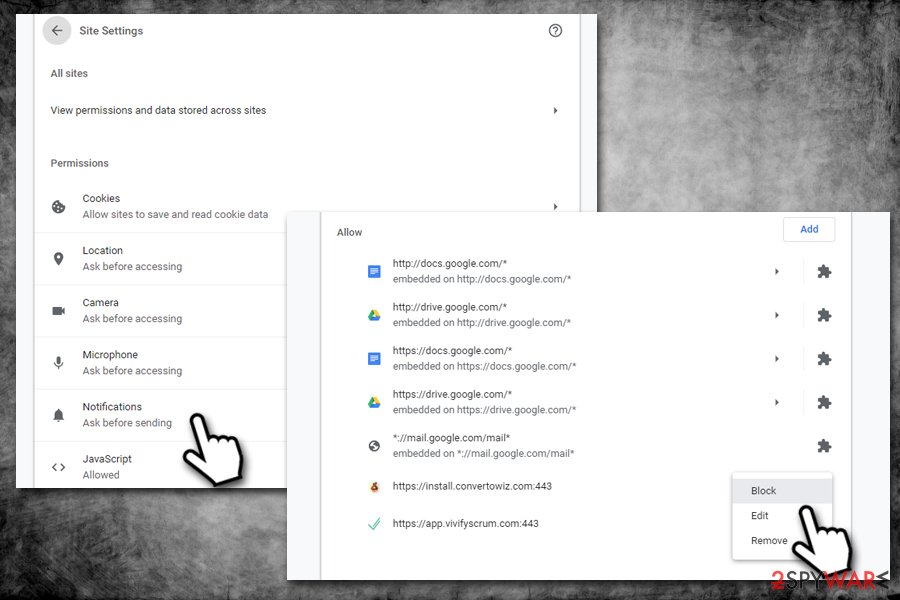Resolvedweighpasswords.com ads (fake) - Chrome, Firefox, IE, Edge
Resolvedweighpasswords.com ads Removal Guide
What is Resolvedweighpasswords.com ads?
Resolvedweighpasswords.com uses fake messages to trick users into agreeing to receive ads

Resolvedweighpasswords.com is one of the thousands of websites that employ a legitimate feature of Google Chrome (or another web browser) to promote dubious, insecure, phishing, and other malicious content to users. These types of scams have been around for many years now, and new websites using them appear every day, tricking thousands.
Upon accessing a website, you would see a pop-up message that allows notifications to be shown. In the background of the page, there would be a message stating the reason why you should do that. Those who are not aware of a scam might proceed with the request.
Unfortunately, by doing this, users give permission to the website to deliver information to them directly at particular time periods. This can be as often as every few minutes to a few notifications a day – it all depends on how the scam authors have configured it.
It is vital you do not click on links within these notifications, as you might be tricked into providing your credit card details or other sensitive information to cybercriminals. Also, you might be convinced that your system has been infected with malware that needs to be removed. This way, you might download and install malicious software on your device.
| Name | Resolvedweighpasswords.com |
| Type | Push notifications, ads, scam |
| Might be related to | Adware or another potentially unwanted program |
| Infiltration | Allowing site to show notifications by pressing the “Allow” button |
| Symptoms | Pop-up ads show up on the desktop at random times |
| Associated risks | Users infected with adware or exposed to dubious notifications might be lead to dangerous websites where they might be tricked into downloading malicious software, providing personal information, or losing money due tech support scams |
| Termination | Notifications can be disabled via the browser settings; in case you experience more ads and redirects to suspicious sites, you should also get rid of adware – use SpyHunter 5Combo Cleaner or another software for a quick elimination |
| Recovery | In case your computer is crashing, returning errors, and is generally sluggish, we suggest you repair it with FortectIntego |
The scheme used by malicious actors who created the site is not complicated. The main tool in this is a legitimate web browser feature – an API – that can be used by any website. All the website creators have to do is include the push notification feature, which will show the notification prompts to all visitors.
The push notification feature, by itself, is not malicious in any way. It allows websites to ask permission to send data to users at particular time intervals if they desire to receive it. When these prompts are used fairly (i.e., visitors are properly informed about what they are subscribing to), there is no problem with it, as they are free to decline this offer.
However, the main goal of cybercriminals is to mislead users and make them believe that the notification prompt is not what it actually is. To be successful, crooks rely on various social engineering[1] tricks, as well as less experienced users. This is because websites like Resolvedweighpasswords.com, Start-xyz.com, or Special-offers-for.me are all copies of one another.
Cybercriminals use templates that work when trying to get people involved in this scheme. It does not require much time to make, and even if tech giants like Google or service providers shut these scams down, new ones can be created very quickly. Here is one of the examples that you could face upon accessing the site:
Click Allow if you are not a robot
In this case, it is implied that by clicking the “Allow” button, users would bypass a security check that is common used by various websites to protect themselves from bots.[2] Since this feature is very familiar to users, they might not know the differences and believe that this is what they have to do to proceed.
You might also encounter different Resolvedweighpasswords.com scam messages; for example, you might see a GIF that shows that an alleged video is about to be played, and you need to press the button to view it. Or you might get a request to press it in order to “confirm that you are 18+”.

Regardless of which version you see, clicking “Allow” will result in one outcome – the website being able to send you unending ads. Additionally, you might be forwarded to other similar or even worse scam, malware-laden sites. Thus, the best thing to do is not to interact with it at all and close the browser tab.
Remove notifications from your desktop
If you have already been tricked into subscribing to the annoying notifications due to the fake messages by the page, do not panic. Thousands of users have the same problem, so you are not alone. As long as you do not engage in notification links, your computer is likely safe.
As already noted, by clicking the “Allow” button, you permitted the site to show you Resolvedweighpasswords.com pop-ups. Luckily, you can easily undo this but accessing the Site settings menu on your browser. Below you will find detailed, step-by-step instructions for all major browsers.
Google Chrome
- Go to Menu > Settings > Advanced.
- Pick Site Settings > Notifications.
- In the Allow section, look for malicious sites.
- Click More Actions and then select Block.

Mozilla Firefox:
- Go to Menu > Options.
- Pick Privacy & Security > Notifications > Settings.
- Click on the the drop-down menu and choose Block.
- Save Changes.

Safari:
- Go to Safari > Preferences…
- Under Websites tab, select Notifications.
- Select the web address in question, click the drop-down menu and select Deny.

MS Edge (Chromium)
- Open Microsoft Edge, and go to Settings.
- Select Site permissions.
- Go to Notifications on the right.
- Under Allow, you will find the unwanted entry.
- Click on More actions and select Block.

Why are you being redirected to Resolvedweighpasswords.com?
Many users believe that their systems are infected with a virus after they start receiving ads unexpectedly. This is because of the intrusive nature of the pop-ups, and as well the fact that most do not realize that they granted permission for these ads to be shown in the first place.
However, there is a slight chance that there could be adware[3] installed on your system that made your browser reroute you to this website. This is especially true if you are experiencing other intrusive symptoms, such as persistent redirects and ads that are appearing on every website that you visit.
Of course, you could have simply been redirected from another website – either after clicking on a malicious link or being taken by URL redirection. However, it is best to be safe than sorry.
The easiest way to check your system for adware is to perform a full system scan with SpyHunter 5Combo Cleaner or Malwarebytes. Security software can also check whether there are malicious processes or files present on your PC. Of course, you can always try removing potentially unwanted programs manually, just like you do with any other app.
If you need help with this process, follow these steps:
Windows
- Enter Control Panel into Windows search box and hit Enter or click on the search result.
- Under Programs, select Uninstall a program.
- From the list, find the entry of the suspicious program.
- Right-click on the application and select Uninstall.
- If User Account Control shows up, click Yes.
- Wait till uninstallation process is complete and click OK.

Mac
- From the menu bar, select Go > Applications.
- In the Applications folder, look for all related entries.
- Click on the app and drag it to Trash (or right-click and pick Move to Trash)

To fully remove an unwanted app, you need to access Application Support, LaunchAgents, and LaunchDaemons folders and delete relevant files:
- Select Go > Go to Folder.
- Enter /Library/Application Support and click Go or press Enter.
- In the Application Support folder, look for any dubious entries and then delete them.
- Now enter /Library/LaunchAgents and /Library/LaunchDaemons folders the same way and terminate all the related .plist files.

If anti-malware software or you yourself found unwanted or malicious programs on your system, you should also clear your web browsers thoroughly. Without doing so, you would allow PUP to continue tracking you, and certain ads may reappear. You can do this quickly with FortectIntego maintenance utility within just a few minutes. If you want to undertake this take yourself, follow the instructions below.
Getting rid of Resolvedweighpasswords.com ads. Follow these steps
Remove from Google Chrome
Delete malicious extensions from Google Chrome:
- Open Google Chrome, click on the Menu (three vertical dots at the top-right corner) and select More tools > Extensions.
- In the newly opened window, you will see all the installed extensions. Uninstall all the suspicious plugins that might be related to the unwanted program by clicking Remove.

Clear cache and web data from Chrome:
- Click on Menu and pick Settings.
- Under Privacy and security, select Clear browsing data.
- Select Browsing history, Cookies and other site data, as well as Cached images and files.
- Click Clear data.

Change your homepage:
- Click menu and choose Settings.
- Look for a suspicious site in the On startup section.
- Click on Open a specific or set of pages and click on three dots to find the Remove option.
Reset Google Chrome:
If the previous methods did not help you, reset Google Chrome to eliminate all the unwanted components:
- Click on Menu and select Settings.
- In the Settings, scroll down and click Advanced.
- Scroll down and locate Reset and clean up section.
- Now click Restore settings to their original defaults.
- Confirm with Reset settings.

Remove from Microsoft Edge
Delete unwanted extensions from MS Edge:
- Select Menu (three horizontal dots at the top-right of the browser window) and pick Extensions.
- From the list, pick the extension and click on the Gear icon.
- Click on Uninstall at the bottom.

Clear cookies and other browser data:
- Click on the Menu (three horizontal dots at the top-right of the browser window) and select Privacy & security.
- Under Clear browsing data, pick Choose what to clear.
- Select everything (apart from passwords, although you might want to include Media licenses as well, if applicable) and click on Clear.

Restore new tab and homepage settings:
- Click the menu icon and choose Settings.
- Then find On startup section.
- Click Disable if you found any suspicious domain.
Reset MS Edge if the above steps did not work:
- Press on Ctrl + Shift + Esc to open Task Manager.
- Click on More details arrow at the bottom of the window.
- Select Details tab.
- Now scroll down and locate every entry with Microsoft Edge name in it. Right-click on each of them and select End Task to stop MS Edge from running.

If this solution failed to help you, you need to use an advanced Edge reset method. Note that you need to backup your data before proceeding.
- Find the following folder on your computer: C:\\Users\\%username%\\AppData\\Local\\Packages\\Microsoft.MicrosoftEdge_8wekyb3d8bbwe.
- Press Ctrl + A on your keyboard to select all folders.
- Right-click on them and pick Delete

- Now right-click on the Start button and pick Windows PowerShell (Admin).
- When the new window opens, copy and paste the following command, and then press Enter:
Get-AppXPackage -AllUsers -Name Microsoft.MicrosoftEdge | Foreach {Add-AppxPackage -DisableDevelopmentMode -Register “$($_.InstallLocation)\\AppXManifest.xml” -Verbose

Instructions for Chromium-based Edge
Delete extensions from MS Edge (Chromium):
- Open Edge and click select Settings > Extensions.
- Delete unwanted extensions by clicking Remove.

Clear cache and site data:
- Click on Menu and go to Settings.
- Select Privacy, search and services.
- Under Clear browsing data, pick Choose what to clear.
- Under Time range, pick All time.
- Select Clear now.

Reset Chromium-based MS Edge:
- Click on Menu and select Settings.
- On the left side, pick Reset settings.
- Select Restore settings to their default values.
- Confirm with Reset.

Remove from Mozilla Firefox (FF)
Remove dangerous extensions:
- Open Mozilla Firefox browser and click on the Menu (three horizontal lines at the top-right of the window).
- Select Add-ons.
- In here, select unwanted plugin and click Remove.

Reset the homepage:
- Click three horizontal lines at the top right corner to open the menu.
- Choose Options.
- Under Home options, enter your preferred site that will open every time you newly open the Mozilla Firefox.
Clear cookies and site data:
- Click Menu and pick Settings.
- Go to Privacy & Security section.
- Scroll down to locate Cookies and Site Data.
- Click on Clear Data…
- Select Cookies and Site Data, as well as Cached Web Content and press Clear.

Reset Mozilla Firefox
If clearing the browser as explained above did not help, reset Mozilla Firefox:
- Open Mozilla Firefox browser and click the Menu.
- Go to Help and then choose Troubleshooting Information.

- Under Give Firefox a tune up section, click on Refresh Firefox…
- Once the pop-up shows up, confirm the action by pressing on Refresh Firefox.

Delete from Safari
Remove unwanted extensions from Safari:
- Click Safari > Preferences…
- In the new window, pick Extensions.
- Select the unwanted extension and select Uninstall.

Clear cookies and other website data from Safari:
- Click Safari > Clear History…
- From the drop-down menu under Clear, pick all history.
- Confirm with Clear History.

Reset Safari if the above-mentioned steps did not help you:
- Click Safari > Preferences…
- Go to Advanced tab.
- Tick the Show Develop menu in menu bar.
- From the menu bar, click Develop, and then select Empty Caches.

How to prevent from getting adware
Do not let government spy on you
The government has many issues in regards to tracking users' data and spying on citizens, so you should take this into consideration and learn more about shady information gathering practices. Avoid any unwanted government tracking or spying by going totally anonymous on the internet.
You can choose a different location when you go online and access any material you want without particular content restrictions. You can easily enjoy internet connection without any risks of being hacked by using Private Internet Access VPN.
Control the information that can be accessed by government any other unwanted party and surf online without being spied on. Even if you are not involved in illegal activities or trust your selection of services, platforms, be suspicious for your own security and take precautionary measures by using the VPN service.
Backup files for the later use, in case of the malware attack
Computer users can suffer from data losses due to cyber infections or their own faulty doings. Ransomware can encrypt and hold files hostage, while unforeseen power cuts might cause a loss of important documents. If you have proper up-to-date backups, you can easily recover after such an incident and get back to work. It is also equally important to update backups on a regular basis so that the newest information remains intact – you can set this process to be performed automatically.
When you have the previous version of every important document or project you can avoid frustration and breakdowns. It comes in handy when malware strikes out of nowhere. Use Data Recovery Pro for the data restoration process.
- ^ What is Social Engineering?. Kaspersky. Resource Center.
- ^ Botnet attacks - everything you need to know. Cdnetworks. CDN Solutions.
- ^ Adware. Wikipedia. The free encyclopedia.
